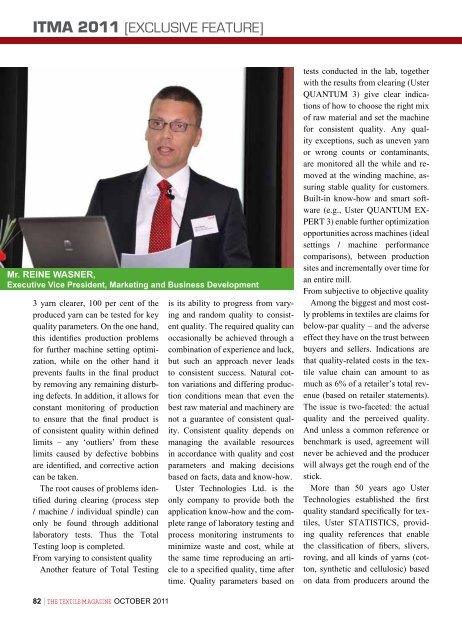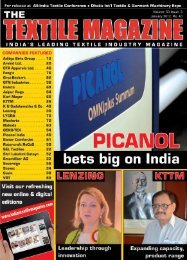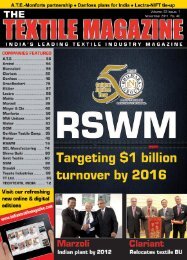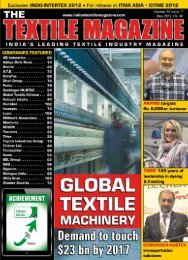00 ItMa 2011 (exclusive Feature) - Textile Magazine
00 ItMa 2011 (exclusive Feature) - Textile Magazine
00 ItMa 2011 (exclusive Feature) - Textile Magazine
You also want an ePaper? Increase the reach of your titles
YUMPU automatically turns print PDFs into web optimized ePapers that Google loves.
itMA <strong>2011</strong> [<strong>exclusive</strong> feature]<br />
Mr. REInE wASnER,<br />
Executive Vice President, Marketing and Business Development<br />
3 yarn clearer, 1<strong>00</strong> per cent of the<br />
produced yarn can be tested for key<br />
quality parameters. On the one hand,<br />
this identifies production problems<br />
for further machine setting optimization,<br />
while on the other hand it<br />
prevents faults in the final product<br />
by removing any remaining disturbing<br />
defects. In addition, it allows for<br />
constant monitoring of production<br />
to ensure that the final product is<br />
of consistent quality within defined<br />
limits – any ‘outliers’ from these<br />
limits caused by defective bobbins<br />
are identified, and corrective action<br />
can be taken.<br />
The root causes of problems identified<br />
during clearing (process step<br />
/ machine / individual spindle) can<br />
only be found through additional<br />
laboratory tests. Thus the Total<br />
Testing loop is completed.<br />
From varying to consistent quality<br />
Another feature of Total Testing<br />
82 | ThE TEXTILE MAGAZINE OCTOBER <strong>2011</strong><br />
is its ability to progress from varying<br />
and random quality to consistent<br />
quality. The required quality can<br />
occasionally be achieved through a<br />
combination of experience and luck,<br />
but such an approach never leads<br />
to consistent success. Natural cotton<br />
variations and differing production<br />
conditions mean that even the<br />
best raw material and machinery are<br />
not a guarantee of consistent quality.<br />
Consistent quality depends on<br />
managing the available resources<br />
in accordance with quality and cost<br />
parameters and making decisions<br />
based on facts, data and know-how.<br />
Uster Technologies Ltd. is the<br />
only company to provide both the<br />
application know-how and the complete<br />
range of laboratory testing and<br />
process monitoring instruments to<br />
minimize waste and cost, while at<br />
the same time reproducing an article<br />
to a specified quality, time after<br />
time. Quality parameters based on<br />
tests conducted in the lab, together<br />
with the results from clearing (Uster<br />
QUANTUM 3) give clear indications<br />
of how to choose the right mix<br />
of raw material and set the machine<br />
for consistent quality. Any quality<br />
exceptions, such as uneven yarn<br />
or wrong counts or contaminants,<br />
are monitored all the while and removed<br />
at the winding machine, assuring<br />
stable quality for customers.<br />
Built-in know-how and smart software<br />
(e.g., Uster QUANTUM EX-<br />
PERT 3) enable further optimization<br />
opportunities across machines (ideal<br />
settings / machine performance<br />
comparisons), between production<br />
sites and incrementally over time for<br />
an entire mill.<br />
From subjective to objective quality<br />
Among the biggest and most costly<br />
problems in textiles are claims for<br />
below-par quality – and the adverse<br />
effect they have on the trust between<br />
buyers and sellers. Indications are<br />
that quality-related costs in the textile<br />
value chain can amount to as<br />
much as 6% of a retailer’s total revenue<br />
(based on retailer statements).<br />
The issue is two-faceted: the actual<br />
quality and the perceived quality.<br />
And unless a common reference or<br />
benchmark is used, agreement will<br />
never be achieved and the producer<br />
will always get the rough end of the<br />
stick.<br />
More than 50 years ago Uster<br />
Technologies established the first<br />
quality standard specifically for textiles,<br />
Uster STATISTICS, providing<br />
quality references that enable<br />
the classification of fibers, slivers,<br />
roving, and all kinds of yarns (cotton,<br />
synthetic and cellulosic) based<br />
on data from producers around the






